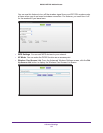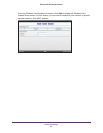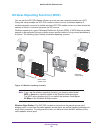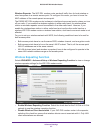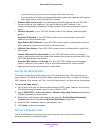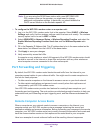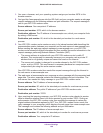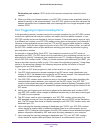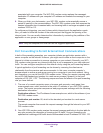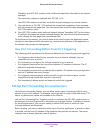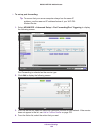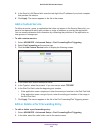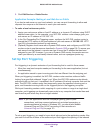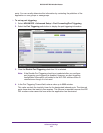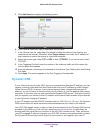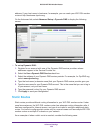
Advanced Settings
102
D6300 WiFi DSL Modem Router
associated with your computer. The WiFi DSL modem router replaces the message’s
destination IP address with your computer’s IP address and forwards the message to your
computer.
8. When you finish your chat session, your WiFi DSL modem router eventually senses a
period of inactivity in the communications. The WiFi DSL modem router then removes the
session information from its session table, and incoming traffic is no longer accepted on port
numbers 33333 or 113.
To configure port triggering, you need to know which inbound ports the application needs.
Also, you need to know the number of the outbound port that triggers the opening of the
inbound ports. You can usually determine this information by contacting the publisher of the
application or user groups or newsgroups.
Note: Only one computer at a time can use the triggered application.
Port Forwarding to Permit External Host Communications
In both of the preceding examples, your computer initiates an application session with a
server computer on the Internet. However, you might need to allow a client computer on the
Internet to initiate a connection to a server computer on your network. Normally, your WiFi
DSL modem router ignores any inbound traffic that is not a response to your own outbound
traffic. You can configure exceptions to this default rule by using the port forwarding feature.
A typical application of port forwarding can be shown by reversing the client-server
relationship from the previous web server example. In this case, a remote computer’s
browser needs to access a web server running on a computer in your local network. Using
port forwarding, you can tell the WiFi DSL modem router, “When you receive incoming traffic
on port 80 (the standard port number for a web server process), forward it to the local
computer at 192.168.1.123.” The following sequence shows the effects of the port forwarding
rule you have defined:
1. The user of a remote computer opens a browser and requests a web page from
www.example.com, which resolves to the public IP address of your WiFi DSL modem
router. The remote computer composes a web page request message with the following
destination information:
Destination address. The IP address of www.example.com, which is the address of your
WiFi DSL modem router.
Destination port number. 80, which is the standard port number for a web server
process.
The remote computer then sends this request message through the Internet to your WiFi
DSL modem router.
2. Your WiFi DSL modem router receives the request message and looks in its rules table for
any rules covering the disposition of incoming port 80 traffic. Your port forwarding rule
specifies that incoming port 80 traffic should be forwarded to local IP address 192.168.1.123.



